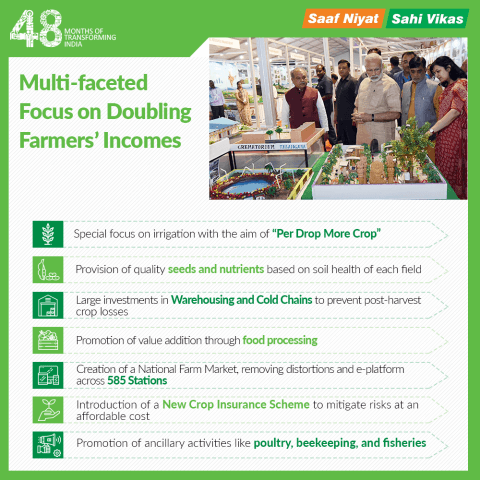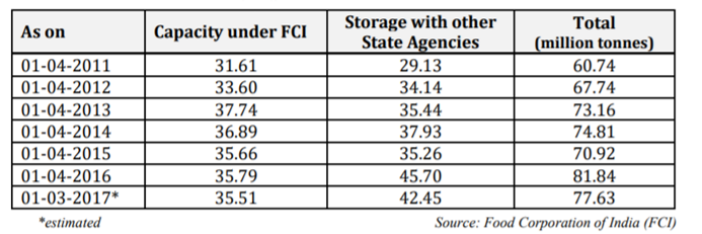[orc]Here is a 2-part series on the claims made by the current government on the initiatives related to Agriculture.
The BJP government has published an infographic on the 48-months portal. The info-graph is a part of a larger sub section on the government’s commitment to farmers. It makes seven claims about the government’s focus on doubling farmers’ incomes. This article is a fact check of the claims made in the infographic.

What is the PMKSY?
‘The Pradhan Mantri Krishi Sinchai Yojana (PMKSY) was launched in July 2015 for providing end-to end solutions in irrigation supply chain, viz. water sources, distribution network and farm level application’ states a response in Lok Sabha.
According to the PMKSY website, ‘It has been conceived amalgamating ongoing schemes viz. Accelerated Irrigation Benefit Programme (AIBP) of the Ministry of Water Resources, River Development & Ganga Rejuvenation (RD&GR), Integrated Watershed Management Programme (IWMP) of Department of Land Resources (DoLR) and the On Farm Water Management (OFWM) of Department of Agriculture and Cooperation (DAC). The scheme will be implemented by Ministries of Agriculture, Water Resources and Rural Development. Programme architecture of PMKSY will be to adopt a ‘decentralized State level planning and projectised execution’ structure that will allow States to draw up their own irrigation development plans based on District Irrigation Plan (DIP) and State Irrigation Plan (SIP). It will be operative as convergence platform for all water sector activities including drinking water & sanitation, MGNREGA, application of science & technology etc. through comprehensive plan. State Level Sanctioning Committee (SLSC) chaired by the Chief Secretary of the State will be vested with the authority to oversee its implementation and sanction projects.’
A response in the Lok Sabha further stated that, ‘the program is composed of three components namely Accelerated Irrigation Benefit Programme (AIBP), River Development and Ganga Rejuvenation (RD & GR), PMKSY (Per Drop More Crop, Cooperation and Farmers Welfare and (Watershed Development) PMKSY. Ministry of Agriculture is the nodal ministry for implementing PMKSY.’
Has there been a special focus on irrigation?
The first claim is that there is a ‘special focus on irrigation with the aim of ‘per drop more crop’.
The report of the committee for doubling farmers’ income states that ‘water source creation, conservation and efficient use (by a blend of systems like micro-irrigation and technology like crop alignment) can promote more crop per drop. PMKSY is based on this principle. There could be a lifesaving or supplementary irrigation during post rainy or fall months which would possibly sustain productive potential of crop through alleviation of moisture stress under conservation agriculture (CA). Local water harvesting by constructing small ponds and using the water via a sprinkler has demonstrated the useful in protecting pulse, crops, during periods of monsoon withdrawal or delay in Karnataka’.
The volume on strategies for sustainability in agriculture provides the strategies for improving irrigation in rain-fed agriculture areas. A response in Lok Sabha from December 2017 states that ‘Rs. 1550.00 crore and Rs. 1990.00 crore were allocated under the Per Drop More Crop component of PMKSY in the year 2015-16 and 2016-17 respectively’.
Claim: Special focus on irrigation with the aim of ‘per drop more crop.’
Fact: Water source creation, conservation and efficient use (by a blend of systems like micro-irrigation and technology like crop alignment) can promote more crop per drop. PMKSY is based on this principle. However, the scheme itself is an amalgamation of existing schemes, implying that there is not a new focus, but continuation of existing programs. Hence, the claim is MISLEADING.
Have quality seeds and nutrients been provided based on soil health cards?
The second claim is that the government is enabling ‘provision of quality seeds and nutrients based on soil health of each field’.
The website of the soil health cards describes that the ‘National Mission for Sustainable Agriculture(NMSA) will be implemented during 12th Plan with the objectives to make agriculture more productive, sustainable and climate resilient; to conserve natural resources; to adopt comprehensive soil health management practices; to optimize utilization of water resources; etc. Soil Health Management (SHM) is one of the most important interventions under NMSA. SHM aims at promoting Integrated Nutrient Management (INM) through judicious use of chemical fertilisers including secondary and micro nutrients in conjunction with organic manures and bio-fertilisers for improving soil health and its productivity; strengthening of soil and fertiliser testing facilities to provide soil test based recommendations to farmers for improving soil fertility; ensuring quality control requirements of fertilisers, bio-fertilisers and organic fertilisers under Fertiliser Control Order, 1985; upgradation of skill and knowledge of soil testing laboratory staff, extension staff and farmers through training and demonstrations; promoting organic farming practices etc.’
According to a response in Lok Sabha, ‘the Government has introduced Soil Health Card (SHC) Scheme during 2015 to assist State Governments to provide Soil Health Cards to all farmers across the country’. Another answer states that ‘Soil Health Card Scheme plays a vital role in enhancing agricultural production in a sustainable manner. The Government has introduced Soil Health Card (SHC) Scheme to assist State Governments to provide Soil Health Cards to all farmers across the country once in a cycle of 2 years. Soil Health Card provides information to farmers on nutrient status of their soil along with recommendations on appropriate dosage of nutrients to be applied for improving soil health and its fertility, which results in enhanced agricultural productivity’.
So, while the government is providing soil health cards and giving recommendations, there is no evidence to prove that it is not providing seeds and nutrients based on the soil health. It also has to be noted that soil health cards are being provided to farmers for a long time now. Soil Health Cards (SHCs) were also distributed during the previous UPA government. According to an answer provided in the Rajya Sabha, the UPA government had setup 1206 Soil Testing Laboratories across the country and issued 5.69 crore SHCs by March 2013.
Claim: Provision of quality seeds and nutrients based on soil health of each field.
Fact: Soil health is being analysed and soil health cards are being provided by the government to the farmers by the state governments and this is being supported by the central government. However, there is no provision of seeds and nutrients based on these cards. Hence, the claim is FALSE.
Have there been large investments in warehousing and cold chains?
The third claim is that there is ‘Large investments in warehousing and cold chains to prevent post-harvest crop losses’.
Report of the Committee for Doubling Farmers’ Income in Volume III titled ‘Post-production Agri-logistics: maximising gains for farmers’ states that ‘the primary development focus for agricultural post-production infrastructure, has been in the form of warehousing and cold stores, for holding inventory for extended durations’. The same report also provides data regarding the stock of rice and wheat held in central pool over the years. It shows that there has been a consistent increase in the central stock since 2011 except for a dip in the year of 2015.

A response in Lok Sabha from 2013 states that ‘generally horticulture produce require cold storages while grains require warehouses. Development of cold storages is promoted in the country under the schemes of the Government, namely, National Horticulture Mission (NHM), Horticulture Mission for North East and Himalayan States (HMNEH), Capital Investment Subsidy for Construction/Expansion/Modernisation of Cold Storage and Storage for Horticulture Produce Scheme of National Horticulture Board (NHB) and Development/Strengthening of Agricultural Marketing Infrastructure, Grading and Standardization (AMIGS). Godowns/Warehouses are developed in the country under the Scheme of Construction of Rural Godowns (RGS), in addition to Food Corporation of India (FCI). Under AMIGS, total number of projects sanctioned so far are 8087 involving subsidy of Rs.782.14 crore. Under RGS, total number of projects sanctioned so far are 30574 with capacity of 383.62 lakh Metric Tonne (MT) involving subsidy of Rs.1294.42 crore. Under the Scheme of NHM, total number of projects sanctioned so far are 652 with capacity of 401.26 lakh MT involving subsidy of Rs.446.12 crore. Under the Scheme of NHB, total number of projects sanctioned so far are 2792 with capacity of 180.63 lakh MT involving subsidy of Rs.789.39 crore’.
Another response in Lok Sabha from January 2018 states that ‘warehouse Infrastructure Fund (WIF) was constituted in National Bank for Agriculture and Rural Development (NABARD), out of the priority sector lending shortfall by Commercial Banks, with a corpus of Rs.5,000 crore for the year 2013-14. Further, a corpus of Rs. 5,000 crore was allocated for the financial year 2014-15. There was no corpus allocated towards WIF for the year 2015-16, 2016-17 and 2017-18. Thus the cumulative allocation towards WIF was Rs.10,000 crore as on 31.03.2015. Since inception, the cumulative sanction under WIF is Rs.7,332 crore and the disbursement made is Rs.4,029 crore. Out of this, an amount of Rs.250.76 crore was sanctioned in 2017-18’.
Claim: Large investments in warehousing and cold chains to prevent post-harvest crop losses.
Fact: While subsidies have been provided and incentives have been provided towards setting up of warehouses and cold chains, there is no verifiable data to conclusively prove large scale investments in this area. Hence, the claim remains UNVERIFIED.
This story is part of a larger series on the 4-years of the Modi government. This series has been made possible with the flash grant of the International Fact Checking Network (IFCN). Read the rest of the stories in this series here


